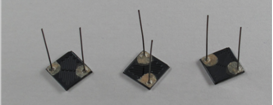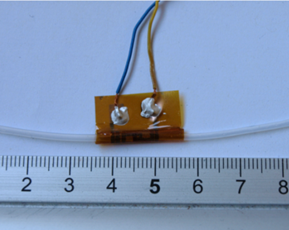Pre-conditioning systems are today highly required in trace detection, either for conventional analytical methods or for gas sensors. There is also a need for the miniaturization and the higher mobility of such detection devices. In consequence, the request of miniaturized components for pre-processing of gases will be more and more important in the future. Pre-concentrators are especially useful for increasing the sensitivity of a detection system toward specific compounds, and also for the pretreatment of gas mixtures to increase the selectivity. In both cases, the micro-component is basically structured with microchannels filled with materials having specific properties in regards to gases, i.e. adsorbent and/or catalysts.
Following the project within the FP6 Network of Excellence GOSPEL during which benefits of using micro-preconcentrators for gas preconditioning have been demonstrated, we are now working on the optimization and integration of the developed technology into concrete miniaturized analytical systems for pollution monitoring and explosives detection. The micro gas preconcentrator will be specifically designed and filled with the appropriate adsorbent material in adequacy to the target compounds such as volatile organic compounds (VOCs), explosives or illicit drugs. The devices are being interfaced either to standard portable GCs with thermal conductivity detectors or micromachined sensitive and selective gas sensors. The use of porous silicon matrices as adsorbent is also being investigated.
A re-design of micro-channels and an evaluation of the potential materials are needed in order to fit the micro-preconcentrator in concordance with the requirements of both integration process and target applications. This optimization includes fluidic and thermal simulations for minimizing the losses charges, the dead volume and maximizing the flow distribution and heater efficiency. A special focus is dedicated on the choice of an adsorbent material and its deposition in microchannels by inkjet printing with adequate sealing strategies. Porous silicon microchannels free of deposited adsorbent are being developed for the detection explosives because of their low adsorption bond towards explosives, in contrast with granular or powder adsorbents.

Silicon micro-preconcentrator filled with carbon powder including integrated heater and fluidic interconnects.
Recently, we have worked on easy to process, low-cost, ligthweight, preconcentrator devices fabricated using additive printing techniques for their realization on polymeric foil. Printing allows the localized deposition of materials at low temperature on large area and can be applied to both the patterning of the heating element and the integration of the gas absorbent material. The tubular shape of the foil gas preconcentrator is obtained by rolling up and sealing the inkjet printed gold hotplate on foil, which is then filled with the gas absorbent material.

Rolled up foil based gas preconcentrator with fluidic interconnects and electrical connections to the printed gold heating element.
Contact: Danick Briand
Scientific publications
E. H. M. Camara, P. Breuil, C. Pijolat, J.-P. Viricelle, N.F. de Rooij, D. Briand, Tubular gas preconcentrators based on inkjet printed micro-hotplates on foil, Sensors and Actuators B, 236 (2016) 1111-1117.
E. H. M. Camara, P. Breuil, D. Briand, J.-P. Viricelle, C. Pijolat, N.F. de Rooij, Preconcentration modelling for the optimization of a micro gas preconcentrator applied to environmental monitoring, Analytical Chemistry, 87 (2015) 4455-4463.
E. H. M. Camara, P. Breuil, D. Briand, N.F. de Rooij, C. Pijolat, A micro gas preconcentrator with improved performance for pollution monitoring and explosives detection, Analytica Chimica Acta 688 (2011) 175–182.
E. H. M. Camara, C. Pijolat, L. Guillot, P. Breuil, D. Briand, N.F. de Rooij, Micro gas preconcentrator in porous silicon filled with a carbon absorbent, Sensors and Actuators B 148 (2010) 610–619.
C. Pijolat, M. Camara, J. Courbat, J.P. Viricelle, D. Briand, N.F. de Rooij, Application of carbon nanopowders for gas preconcentration, Sensors and Actuators B, 127 (2007) 179-185.